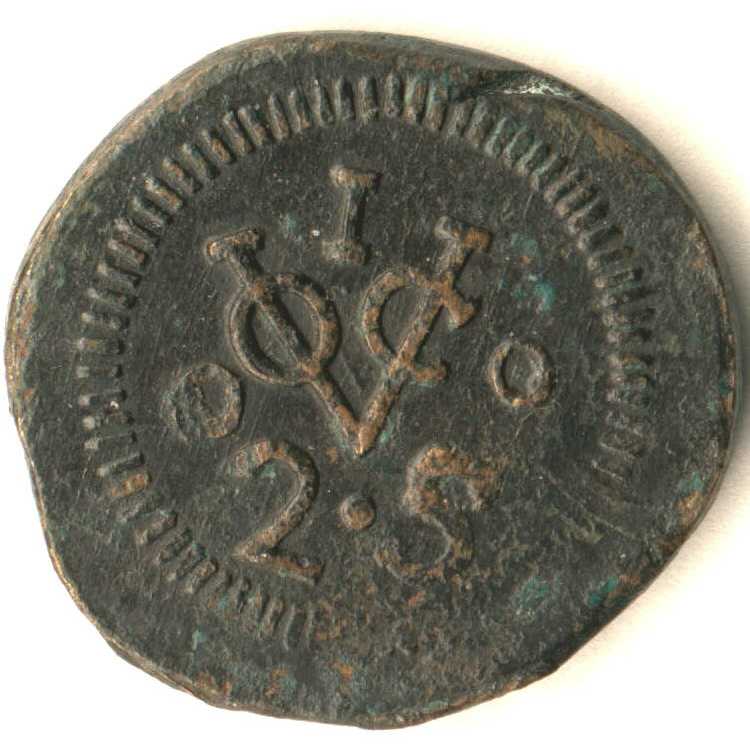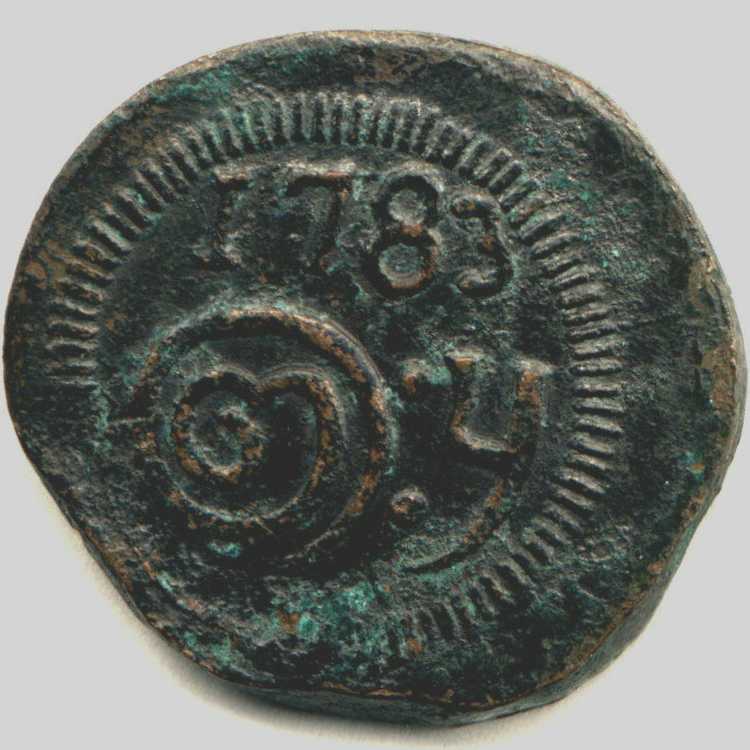| SPECIFICATIONS | |
| Denomination | Two Stuiver |
| Alloy | Copper |
| Type | Struck |
| Diameter | 31.4 mm 29.3 mm |
| Thickness | 5.5 mm |
| Weight Legal | 26.7 gms |
| Weight | 30.88 gms |
| Shape | round |
| Edge | Dump |
| DieAxis | 0° |
| Mint | Jaffna |




|

| 
| ||||||||||||||||||||||||

| 
| |||||||||||||||||||||||||
| Schloten 1320b; Krause #29 | ||||||||||||||||||||||||||
Obverse : I (Jaffna) above VOC monogram between Annulets; Value 2.S below; within Rim of dashes.
Reverse : Year 1783; value in Tamil @:y. = 1/2 P (1/2 fanam) below; within Rim of dashes.
Both sides
Is the coin is 15.7% over legal weight ?, It is similer to weights in Grogan 601-603 for the 1783 Jaffna 2 Stiver: 30.47, 32.48, 31.33 grams.
The coin has been struck on a larger flan, like and die identical to the illustrated lot 960 of Baldwin's Auction #27 of Ton Eijkelenkamp collection. The RR coin shown above appears to be higher grade.
The 600 dpi images loaded are shown at 200 dpi to display within page. Please left click on image and view image at full resolution. The obverse shows some straight streaks. I suspect that is toning after a poor cleaning or some protecting wax rubbed on coin. It did not wash out with soap and water.
| KM29 | S1320a | RR | 1783 | The monogram between 0-0, : between Tamil letters and . after latter. Annulet o above date. iRm of dashes. |
| KM29 | S1320b | RR | 1783 | larger Tamil letters, no dot after them |
| KM29 | S1320c | RR | 1783 | monogram between .-. Rev. . above date and . between Tamil letters, dotted rim |
| KM29 | S1320d | RR | 1783 | similar, . after date |
| KM29 | S1320e | RRR | 1783 | monogram with 0 0 in lieu of 0 C |
| KM29 | S1321a | RRR | 1784 | '.. between Tamil letters |
| KM29 | S1322 | RRRR | 1786 | (over 1783) [1 Moquette Sale (1929) No.320 only.] |
| KM29 | S1323 | RRRR | 1787 | with two dots above and one dot under the 8, 7 upside down |
| KM29 | S1325a | RR | 1792 | with <:.>-+ and: 2 S (2 S divided by a short upright stroke); dot after date |
| KM29 | S1325c | RR | 1792 | as a with 2.S |
See also companion list of Jaffna 2 Stiver coins with Tamil letters interchanged.
To the end of their rule the Dutch had a special system for counting taxes at Jaffna: 5 doits = 1 tammekas; 10 tammekas = 1 fanam; 12 fanams = 1 rixdollar.
Minting in Jaffna as was also done at Galle, was under the supervision of the local employees of the Company. The text is in Tamil which had been the vernacular of Jaffna, in the North of Lanka, for centuries. Sinhala was used on the coins minted in Galle in the South of the Island.
The Stuivers were struck in accordance with the weight of the Stuivers of Colombo. The minting of Dudus anywhere but at Colombo was disapproved of by Batavia. Since, however, the Mint at Colombo was already overtaxed and it had to rush to be able to supply Jaffna and Galle with coining material before the end of the sailing season.
Text from
* Ceylon Coins and Currency By H. W. Codrington. Colombo 1924
Page 134 Chapter X Dutch - Coins of the Eastern Mints. C - Jaffna Plate 137.
* The Coins of the Dutch Overseas Territories- 1601-1948
C. Scholten, 1953, Amsterdam: Jacques Schulman.
The coin was scanned at 600dpi and the images are displayed at 200dpi. It was purchased on eBay in September 2003 from a dealer in UK who said he got it in a collection over 10 years ago. It was listed on eBay with no images and the seller lost E-mail contact and did not reply during Auction. Bid was a gamble.
The 1783 Jaffna Mint 2 Stiver is listed as RR (Very Rare) in Scholten and but he does not list the large flan variety, which has sold in many leading Auctions. A dealer listed one on eBay which weighs 45.7 grams and said he had said he had seen one which weighs 52 grams. The Mints in 1783 knew how to get weights right and did not issue heavy weight coins at a loss. Heavies were either shaved or remelted. As the eBay seller suggested the coin does represent experimenting at a Mint, but not in 1783, but a mid 20th century. Those who replicate Replicate coins in Sri Lanka have little knowledge about what the coin should weigh and they show much dispersion in weight.